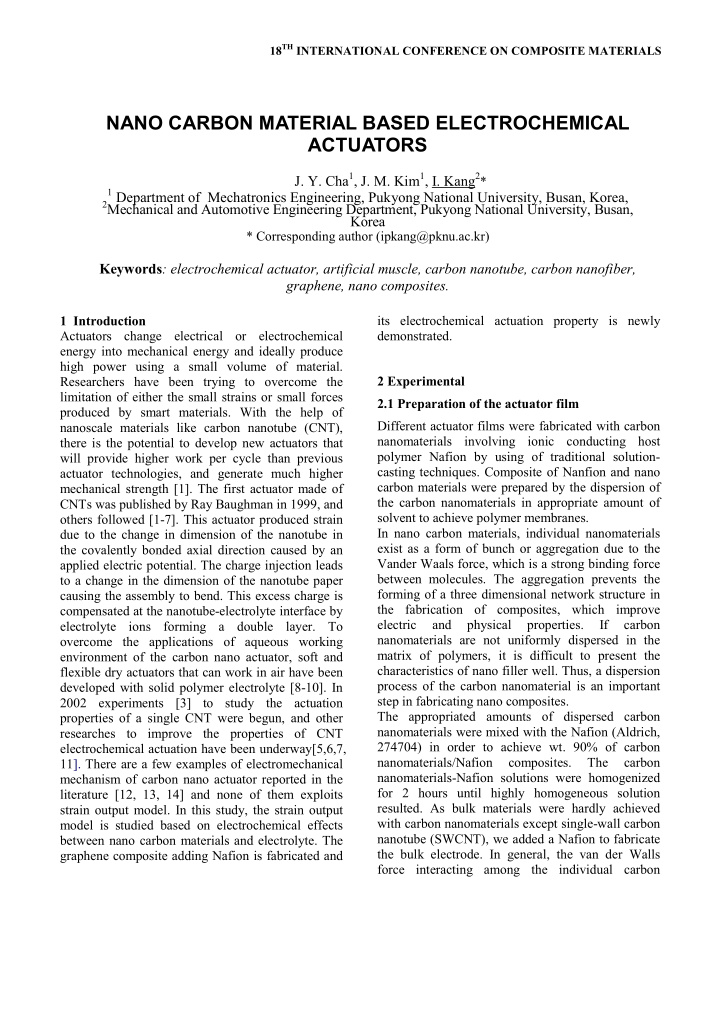



18 TH INTERNATIONAL CONFERENCE ON COMPOSITE MATERIALS NANO CARBON MATERIAL BASED ELECTROCHEMICAL ACTUATORS J. Y. Cha 1 , J. M. Kim 1 , I. Kang 2 * 1 Department of Mechatronics Engineering, Pukyong National University, Busan, Korea, 2 Mechanical and Automotive Engineering Department, Pukyong National University, Busan, Korea * Corresponding author (ipkang@pknu.ac.kr) Keywords : electrochemical actuator, artificial muscle, carbon nanotube, carbon nanofiber, graphene, nano composites. 1 Introduction its electrochemical actuation property is newly Actuators change electrical or electrochemical demonstrated. energy into mechanical energy and ideally produce high power using a small volume of material. 2 Experimental Researchers have been trying to overcome the limitation of either the small strains or small forces 2.1 Preparation of the actuator film produced by smart materials. With the help of Different actuator films were fabricated with carbon nanoscale materials like carbon nanotube (CNT), nanomaterials involving ionic conducting host there is the potential to develop new actuators that polymer Nafion by using of traditional solution- will provide higher work per cycle than previous casting techniques. Composite of Nanfion and nano actuator technologies, and generate much higher carbon materials were prepared by the dispersion of mechanical strength [1]. The first actuator made of the carbon nanomaterials in appropriate amount of CNTs was published by Ray Baughman in 1999, and solvent to achieve polymer membranes. others followed [1-7]. This actuator produced strain In nano carbon materials, individual nanomaterials due to the change in dimension of the nanotube in exist as a form of bunch or aggregation due to the the covalently bonded axial direction caused by an Vander Waals force, which is a strong binding force applied electric potential. The charge injection leads between molecules. The aggregation prevents the to a change in the dimension of the nanotube paper forming of a three dimensional network structure in causing the assembly to bend. This excess charge is the fabrication of composites, which improve compensated at the nanotube-electrolyte interface by electric and physical properties. If carbon electrolyte ions forming a double layer. To nanomaterials are not uniformly dispersed in the overcome the applications of aqueous working matrix of polymers, it is difficult to present the environment of the carbon nano actuator, soft and characteristics of nano filler well. Thus, a dispersion flexible dry actuators that can work in air have been process of the carbon nanomaterial is an important developed with solid polymer electrolyte [8-10]. In step in fabricating nano composites. 2002 experiments [3] to study the actuation The appropriated amounts of dispersed carbon properties of a single CNT were begun, and other nanomaterials were mixed with the Nafion (Aldrich, researches to improve the properties of CNT 274704) in order to achieve wt. 90% of carbon electrochemical actuation have been underway[5,6,7, nanomaterials/Nafion composites. The carbon 11]. There are a few examples of electromechanical nanomaterials-Nafion solutions were homogenized mechanism of carbon nano actuator reported in the for 2 hours until highly homogeneous solution literature [12, 13, 14] and none of them exploits resulted. As bulk materials were hardly achieved strain output model. In this study, the strain output with carbon nanomaterials except single-wall carbon model is studied based on electrochemical effects nanotube (SWCNT), we added a Nafion to fabricate between nano carbon materials and electrolyte. The the bulk electrode. In general, the van der Walls graphene composite adding Nafion is fabricated and force interacting among the individual carbon
nanomaterials is not enough to form a film. Nafion not only combines nanotubes as a matrix but it also greatly improves the electrochemical activity. 2.2 The nano carbon actuation in an aqueous electrolyte The electrochemical nano carbon actuator is a strain induced one by volume change, i.e. the volume of nano carbon materials can be expanded by ion exchange when it is immersed in an electrolyte. If a voltage source is connected to the nano carbon, because of the electrical charging effect, anions and cations in an electrolyte would attach on the surface of cathode nano carbon and anode nano carbon Fig.2. SWCNT actuator coating with Nafion respectably. To achieve the actuation of nano carbon working in aqueous NaCl electrolyte. material, actuator film was immersed into an aqueous electrolyte and AC voltage was applied to aqueous electrolyte has been demonstrated [2]. The the film as a power source. The basic experimental aligned MWCNT arrays actuation has been reported setup is provided in Figure 1. as an electrical repulsion among nano tube forests Figure 2 shows an experiment of CNT bi-morphing which means a rather different actuation mechanism actuator made of Nafion coated SWCNT which is than SWCNT. The carbon nanofiber (CNF) sheet actuating in 5M aqueous NaCl electrolyte. The manufacturing process was developed and it can be actuation amplitude is 5 mm when driven by the used for MWCNT actuator as well. Figure 3 shows a square wave and it can vibrate at frequencies up to manufactured CNF adding Nafion (wt. 90/10) and 15 Hz. its actuating with volume expansion similar with Since multi-wall carbon nanotube (MWCNT) has SWCNT actuator. Because of poor electrochemical been reported to be difficult to produce macroscopic and electrical properties, the bending occurs mostly sheet, its actuation property has not been studied near the top of the film. well. Only forest-like aligned MWNT actuator in Because of the Nafion infiltration, MWCNT and CNF can bind with hydrogen boding and it helps to bind the tubes each other to make a film type. Since Nafion also has an actuation property dues to redox mechanism [6, 7], this study had validated that the actuation property does not owing to the Nafion actuation. Fig. 3. CNF actuator with Nafion coating: (a) Fig.1. Nano carbon actuation in aqueous electrolyte Nafion coated CNF film; (b) actuation with experimental setup. volume expansion.
Recommend
More recommend